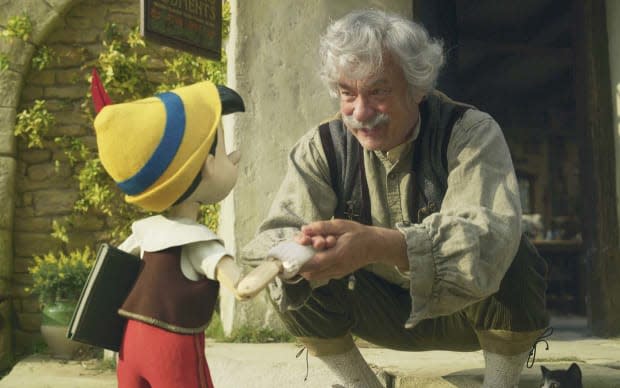'Pinocchio' Movie Review
- Oops!Something went wrong.Please try again later.

A classic fairy tale comes to magical life once again in this tall tale of a wooden puppet who longs to become a real boy.
Pinocchio, the little Italian marionette, has been around for quite a while—almost 250 years, in fact. His roots are in a novel published in the late 1880s by Tuscan author Carlo Gilodi, and his story “came alive” for American audiences with the beloved 1940 animated Disney film that’s still considered an unqualified House of Mouse-terpiece and a high-water mark for golden-age, hand-illustrated cinematic storytelling.
Pinocchio
Starring Tom Hanks, Luke Evans and the voices of Joseph Gordon-Levitt & Benjamin Evan Ainsworth
Directed by Robert Zemeckis
Rated PG
How to Watch: Streaming Sept. 8 on Disney+
Following the vintage blueprint of the 1940 version, the new Disney version makes a few notable tweaks; some new things are added, some old things axed for this eye-catching combo platter of live performance and state-of-the-art computer animation. Pinocchio purists may flinch, but hey, the 1883 novel ends with a real downer—the little puppet is hanged and executed. So just keep that in mind; even Disney-fied, this is an existential “hero’s journey” cloaked in danger and a descent into darkness. Ol’ Walt felt the original Italian folktale was too harsh and off-putting, especially for his sunshine factory, so he scrubbed it up considerably in 1940.
This new-nocchio features the venerable Tom Hanks as Geppetto, the aging woodcarver and clockmaker who fashions a “boy” puppet to fill the void of what is presumed to be the death of his young real-life son. After wishing upon a star—that his creation of pine could somehow come to life—his cottage is visited by the ethereal Blue Fairy (Cynthia Erivo), who grants the wish. Pinocchio (voiced by British newcomer Benjamin Evan Ainsworth) becomes sentient and animated, able to move without strings, but naïve to the ways of the world, its temptations and its treachery. So, Jiminy Cricket (voiced by Joseph-Gordon Levitt), a dapper little insect onlooker, is appointed the role of Pinocchio’s conscious, an important barometer to help him steer right instead of wrong.
The Blue Fairy tells Pinocchio that if he wants to be truly real, he must show himself to be “brave, truthful and unselfish.” And, as almost everyone knows, if he ever tells a lie, his nose will know—and grow and grow and grow.
Which, as it turns out, comes in handy.
And so begins Pinocchio’s wild adventures—kidnapped by a pair of street scallywags, a sly fox misleadingly named “Honest John” (voiced by Keegan-Michael Key) and his scraggly alley-cat cohort; sold as a novelty into puppet slavery to the greedy, bloated showman Stromboli (Italian actor Giuseppe Batson); escaping, only to find himself on Pleasure Island, where its cornucopia-carnival of anything-goes “pleasures” turn out to be only temporary.
And then Pinocchio ends up in the belly a fearsome sea creature known, appropriately enough, as Monstro.
How and this all wraps won’t be any surprise to anyone familiar with the tale, but one of Disney’s new tweaks is the ending—perhaps not as satisfying as a lot of people would wish, and that’s all I’ll divulge about that. But the story’s overtones about honesty, heroism and the importance of good behavior are very much intact. And kids: Stay in school!
And this being Disney, in the modern enlightened age of flagrant self-promotion, you’ll even get a wink-wink, yuk-yuk reference to actor Chris Pine (who’s starred in five Disney movie projects, including Into the Woods and A Wrinkle in Time), and a cuckoo display of characters from other classic Disney films, from Snow White to Roger Rabbit and Toy Story.
Erivo, the Oscar-nominated British actress who’s played slave activist Harriet Tubman and musical legend Aretha Franklin, shines (literally) in her one scene as the Blue Fairy, a beacon of light belting out the memorable tune from Disney’s 1960 version that became a an Oscar winner—“When You Wish Upon a Star.” Another familiar song from the classic animated version is “High-Diddle-Dee-Dee (An Actor’s Life for Me),” and Pinocchio sings “I’ve Got No Strings” while he’s prancing on stage with a squad of can-can marionettes. But Jiminy Cricket is robbed of his signature song, “Give a Little Whistle,” which is a bit of a bummer.
Luke Evans—most recently starring in Hulu’s Nine Perfect Strangers—has an enhanced, singing/dancing role as the coachman, who drives kids to their fates on Pleasure Island, and Lorraine Bracco is the voice of Sofia, a helpful seagull.
Director Robert Zemeckis knows movie magic—he took us Back to the Future in two movie sequels, marooned Tom Hanks in Cast Away and gave the world Forrest Gump. His stylish new spin on Pinocchio is a dazzling display of filmmaking, a seamless integration of hyper-realistic FX and human actors. Appropriate, I’d say, for a story about a wooden boy who longs to become real.
An artful new spin on an old, old tale, it likely won’t become a new-age Disney classic—not so long as the 1940 original is around, anyway. But this solidly fanciful fable vibrantly, creatively dusts off the years from pop culture’s most famous puppet.
And I’m not just pulling your strings.
